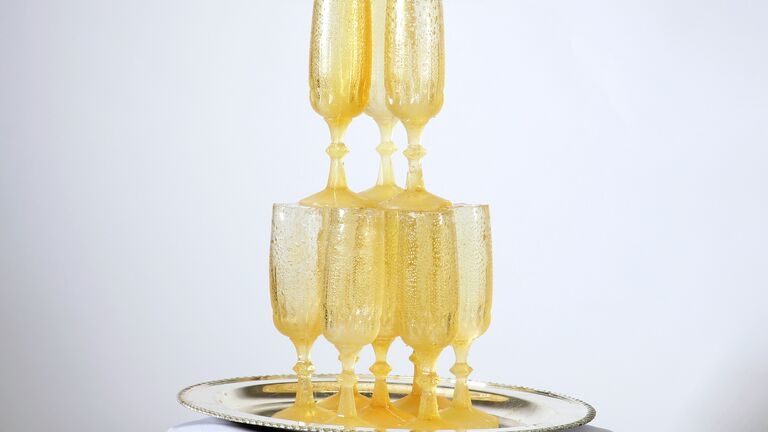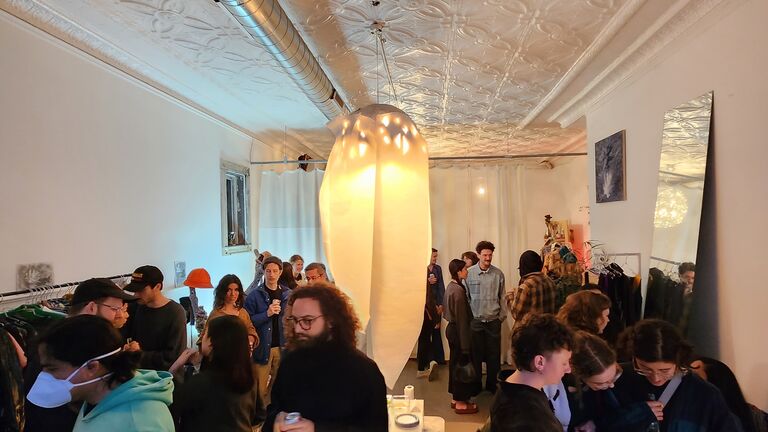
Katie Rauth (MFA 2022), Hostess
Tiny Table Gallery’s Love of Small Sculptures
When attending an opening at Tiny Table Gallery, visitors may be surprised by what they see. Unlike the classic gallery opening where visitors wander around examining various pieces of art hung on walls or sitting on pedestals, crowds gather around one small sculpture sitting on a tiny table. Whether it's an embellished toy phone or a photo album adorned with porcelain pieces, Tiny Table’s format takes the familiar obsession with cute, tiny trinkets to a whole new level.
Tiny Table Gallery is a non-commercial project space run by four School of the Art Institute of Chicago (SAIC) students and alums: Sophie Buchmueller (Dual MA 2022), Johnny Doley (MFA 2023), Kelly R Johnston (MFA 2024), and Alice Matthews (Dual MA 2023). They all participated in the Abakanowicz Fellowship through the SAIC Institute for Curatorial Research and Practice. This fellowship served as a laboratory of sorts for students to experiment with curatorial practices under the guidance of SAIC faculty members and a working artist. In this incubator, the idea for Tiny Table Gallery was born.

The founders of Tiny Table
As part of the fellowship, the group visited the Circle Drive-In Flea Fair in Scranton, Pennsylvania, where they created an activation using objects from the fair. At the flea market, the group was enchanted by a salesman sample table for sale and used it to showcase other found objects. Matthews describes their methodology as an alternative flea market of sorts. “It was interesting to think: How do we adapt the mechanisms of the flea market, but then do it in a way that’s a little odd? Or, having visitors trying to figure out—are they part of the flea market? Are they not part of the flea market? What’s going on?” she said. In the project’s culminating exhibition, Everything Could Go, a faculty member suggested that the group consider using the tiny table as a platform for art objects.
Now, Tiny Table Gallery continues its focus on small-scale sculptures. Their placement and the gallery’s format make these often overlooked objects demand attention. Tiny Table’s exhibitions take on a time-based format, in which each sculpture is displayed on the table for about 10 minutes at a time. The curators will then switch out the sculpture with the next one and place the previous one on a larger table for visitors to admire if they were not present for the reveal.

Maddie May (MFA 2022), Scrub
Many of the sculptures that sit on the table use unconventional materials. Maddie May’s (MFA 2022) Scrub consists of dial gold soap, glycerin, and dust to create a large, tactile play on a soap holder. Other sculptures utilize the table in an atypical way, such as Associate Professor Adrian Wong’s Peach Scree, no. 1 (circa 1950), whose sculpture takes on the appearance of a giant rock that the tiny table sits upon. Some sculptures are even interactive, such as Katie Rauth’s (MFA 2022) Hostess, in which the artist created a champagne tower out of their sculpted sugar glasses and served champagne in their sugar glasses for visitors to enjoy.
The ritualistic nature of exhibiting art on the tiny table has become a performance audience members look forward to. “What I found so captivating about our [second] show, was that every time we came to switch a piece on the table,” Johnston said, “all of a sudden, the whole crowd got really quiet that you could hear a pin drop, and then we’re carrying the piece out, it’s on the table, there’s applause . . . [It] creates these magical moments of community building.”

The crowd at Bright day would turn to night, my love at TUSK
Since the table has moved to Chicago, the gallery has put on three exhibitions: Plaything at Comfort Station, Make You Make Me at free range, and Bright day would turn to night, my love at TUSK. When asked about their process of curating a show, Buchmueller said, “We have these broad themes that we’re interested in exploring, and so, we start by asking, ‘We want to do a show on this; whose practice resonates with this idea?’ And then, of course, the theme changes and evolves based on the artists, too.”
Given that Tiny Table Gallery doesn’t have a permanent physical space, they’ve developed a digital exhibition space through their Instagram account @tinytablegallery. The team photographs each sculpture and creates an Instagram post promoting the object and the artist. In their most recent exhibition, they photographed each artwork outside at Montrose Beach, transforming the photos themselves into art.
Tiny Table Gallery’s current Instagram bio reads, “Chicago for now,” and its founders are still deciding how they want to evolve. “We are really just beginning to scratch the surface of what we wanna do with this project,” said Doley. Ultimately, Tiny Table’s goal is to bring elements of fun and play into the art world. Whether it is through their experimental exhibition style or simply featuring petite artworks, Tiny Table Gallery proves that anything, even a tiny antique table sold at a flea market, has the potential for creating something extraordinary.
